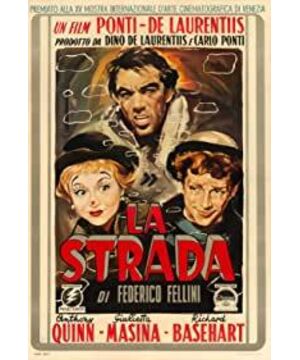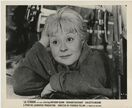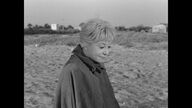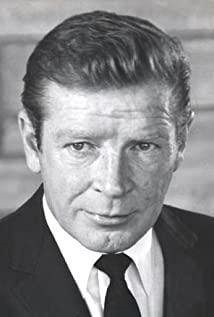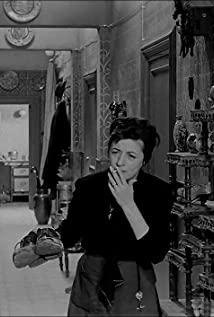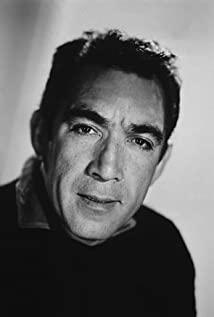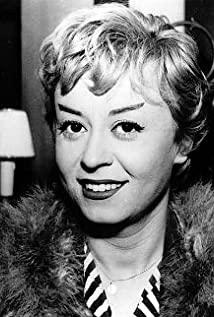The entire plot of "The Great Road" is reduced to a burlesque performance. During the performance, Zambano shoots Gersomina, and the savage force knocks Gersomina down, but he himself is knocked to the ground, and he is very embarrassed. The reference to the burlesque is that Gersomina was crushed and abandoned by the beastly Zambano, but the incident made him feel emotional, and when he learned of the latter's death, he turned his feet on him. Heaven and earth cry on the beach. This detail was first discovered by Márquez, but I found a similar burlesque that Fellini used more than once. In "Night of Kabylia", Kabylia participated in a performance of a psychological drama. She asked the fictional Oscar: "Will you really not abandon me?" The host's face changed suddenly, and the whole play stopped abruptly. end. This detail hints at the tragic fate of her being deceived by "Oscar".
The main point of "The Great Road" is not the plot, but the creation of two diametrically opposed people. Zombaño is a person who only pursues metaphysical things such as appetite and sexual desire, while Gersomina is an innocent, romantic person with an artist's breath. Therefore, communication between the two is extremely difficult. In the beach scene, Gersomina said to Zambano: "I used to want to go home, but now I don't, where you are is my home." It was an affectionate confession, and the reply was: "Very good, so you won't starve to death." In the scene outside the police station, Gersomina proudly said to Zambano, "The circus advised me to leave, but I didn't." Zambano did not hear Gersomina's implication, simply "Then you should have left." The chicken-and-duck talk between the two reached its peak in the scene of the rainy night in the monastery. The zero communication between Zambano and Gersomina is very similar to that of Ciel and Emma in Madame Bovary. Emma was immersed in the fantasy brought by romance novels, and she did not have a good communication with Ciel until her death. For two people who get along day and night, no communication means loneliness, and this loneliness is worse than a person's loneliness. As the relationship deepened, did the two change each other and make the loneliness disappear? I don't think Gersomina has changed. She was always innocent and romantic, and this innocence led to her death. Zambano, on the other hand, was approaching Gersomina. Gersomina mentioned his ex-wife to Zambano three times, the first time Zambano told her to shut up, the second time Zambano ignored it, and the third time Zambano said sadly "I don't want to mention it again. It's over." In the scene in the wilderness, Gersomina lost her nerves because of Ilmato's death, Zambano looked at Gersomina distressedly, and expressed remorse for the accidental murder. It can be seen from these details that Zambano has changed, but it has changed too little and too late. At the end of the film, Zambano weeps on the beach after learning of Gersomina's death. The fall of such a beautiful life can revive even the heart of a beast.
Here comes the question: why did Gersomina choose the beastly Zambano? Wouldn't the gentle and kind Ilmato be a better choice? There is a kind of interpretation that Gersomina is replaceable by others, only Zambano really needs her, and she finds the value of existence in Zambano. But Gersomina can have such wishful thinking only if she falls in love with Zambano, an interpretation that is circular. Gersomina loves Zambano for no reason. Zambano, who pursues metaphysics, represents realism, and Gersomina, who pursues metaphysics, represents surrealism. This is of course a loose statement, but it allows this article to advance to the part of film history. After World War II, the neorealist film genre emerged in Italy, which mainly reflects the discussion of four basic issues of human existence: against war, against unemployment, against hunger and injustice, against family disintegration and degeneration. The genre has done a great job of breaking the formulaic film mold, but it has been fraught with crises since the day it was born. Neorealist movies try to restore the reality of appearances through live shooting, non-professional actors, long shots, etc. In this case, why should the audience go into the theater? Why not just observe life directly? Therefore, the good times of neorealist films did not last long, and the release of "The Great Road" in 1954 marked a turn for it.
Anti-drama is the aesthetic feature that distinguishes neorealist cinema from all cinematic forms (including old realism). "The Great Road" is unquestionably anti-dramatic. In "The Great Road", Zambano has performed five times to break the chain. In his fifth performance, he was weak and traumatized, and almost all the audience believed that he would splatter blood on the spot to pay off his sins, but he still successfully completed the performance. Coincidentally, in "Night of Kabylia", in order to prevent the audience from discovering that Kabylia was deceived at the end of the play, "Oscar" put on sunglasses before entering the jungle, telling the audience that he was a bad guy. The same is true in The Bicycle Stealer, a masterpiece of neorealist film, the whole incident is nothing more than Antonio's failure to pursue a bicycle, and his forgiveness for stealing a bicycle, which is not enough to write in the smallest newspaper. Anti-drama is the most apparent truth, because there are not so many adventures in life. "The Great Road" is a turning point for neo-realism films, turning to personal realism and pursuing spiritual truth. Both Zambano and Gersomina are outcasts living at the bottom of society, and if the film focused on the oppression of the rich against them, it would be a traditional neorealist film, but "The Road" doesn't go in that direction , but pay more attention to the spiritual world of people. "The Great Road" blurs time and space. In the places where Zambano and Gersomina perform, we cannot see the daily life of the people. The two are performing arts from one place to another, like from one isolated island to another isolated island, connecting the isolated island is an endless road. In "The Bicycle Stealer", the daily life is clear, and the class is also clear, especially in the restaurant scene. There are two other details in "The Great Road" that demonstrate this. Gersomina once asked about Zambano’s hometown, and Zambano replied that it was his hometown. Gersomina asked again, and Zambano just answered his father’s house. The only time the location is mentioned in the play is "in Rome," as the circus master's wife said, but the location doesn't make any sense. The purpose of blurring time and space is to pursue the universal meaning of the spirit and not be disturbed by the material world.
In the monastery scene, the nun said to Gersomina, I follow my God, you follow your husband, and we each go our separate ways. It's a manifesto for a spiritual journey, reminiscent of modernist works like On the Road. Material truth needs realistic symbols to carry, such as the homeless, broken house, while spiritual truth needs surreal symbols. According to Bazin, the most important surreal symbol in "The Great Road" is the angel. Ilmato appeared wearing a pair of angel wings, the spotlight hit him, he stepped on the wire and looked down at the crowd. Tears were drawn on his eyes, hinting at his unfortunate fate. He will speak to Gersomina on an equal footing, soothing her lonely and restless heart. The horse is also a surreal symbol. While Gersomina was waiting outside the tavern for her husband, a huge horse appeared, occupying almost the entire scene. The clatter of the horse's hoofs stamped out the sound of the clock (the passage of time), as well as Gersomina's impatience and humiliation. In addition, the horse is a symbol of desire in Western culture. Taking "Madame Bovary" as an example, after Charles and Emma left the Marquis Manor, the viscount's steed galloped past. It carried Emma's desire, and it was also appropriate to migrate to Gersomina. The fly is also a surreal symbol. Gersomina was waiting for her husband to have sex at the wedding when two flies landed on her shoulders. The fly symbolizes Gersomina's tainted pure emotion. Contrasting with Madame Bovary, the most famous setting in this novel is a fly falling into a cider glass, the fly symbolizing Emma's boredom and restlessness. There are many other symbols of this type, such as the strange child on the hospital bed and the dead dog at the entrance of the village. Unfortunately, the author has not been able to decipher their meaning. In general, there are no real angels or other impossible things in "The Great Road" after all. These symbols can still be understood with the logic of realism, which is why "The Great Road" is still regarded as a neo-realist film. one. There is another class of elements that have plot meanings that cannot simply be called surreal symbols, but also have metaphorical meanings. Like a circus. The colors of the circus are gorgeous, which has the effect of defamiliarization and prolongs the time for the audience to think about it. The performances of all the clowns in the circus are joyous, hide their inner grief and loneliness, and metaphorize everyone's living state. In addition, the circus can unleash the instincts of human nature that oppose reason. As Calvino put it: "The circus offers Fellini's films another world, one that is confused with sensuality and offers the illusion of sensuality". The meaning of the circus is obscure, and its interpretation requires reference to Fellini's life and other works. There is also the element of religious processions. "Card The meaning of the religious procession in Billia Nights is clear. It shows the despair of mankind in the absence of God. The interpretation of this element in "The Great Road" can only draw on this. Gersomina was pushed into the procession, and she also played the role of an outsider during the procession. In other words, she does not believe in God, and God is absent. The assembly dissipated, the bells rang, Zambano came galloping, Gersomina found her faith, and love was her faith. It is an attempt by tiny individuals to find salvation.
There are both realistic and surreal parts in "The Great Road", marking the turn of neorealist cinema. It is a road in which various creative genres and methods go hand in hand. Since only the surreal parts of "The Great Road" were appreciated, Fellini worked more and more in the direction of the surreal, parting ways with realism, that is, the narrowing of the road. But critics have little influence on Fellini's turn, and the revival of the Italian economy and Fellini's own interest are more important reasons. Moreover, the narrowing of the road is not a blessing. Whether it is realism or symbolism, it is just a lens for observing the world, and the lens itself is not good or bad. The great "Eight and a Half" and "Amakord" are not works of realism, which shows that Fellini is taking the path that suits him.
View more about La Strada reviews


